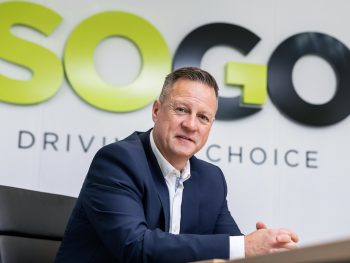What 2022 has in store for fleets
After a year like no other, Fleet World asks the fleet sector to future-gaze on 2022 and predict what the sector is likely to see.
Guessing what the future has in store seems a bit of a tall ask on the back of the last two years.
But after a momentous year that saw the world accelerate climate action at COP26, while fleets fast-tracked EV adoption and continued managing the pandemic fall-out, we look at what the next 12 months may bring.
Prepare for fast-paced changes in EVs and the auto sector

Alfonso Martinez, managing director at LeasePlan UK, says fleet managers should prepare as much as possible for the potential impact of CAZs
With only eight years to go until 2030, there’s no doubt that this year promises a lot for fleets and motorists to grapple with – particularly when it comes to EVs, according to Alfonso Martinez, managing director at LeasePlan UK.
“We already know that the Electric Vehicle Homecharge Scheme will end for homeowners in single-unit properties, and instead be re-focused on leaseholders, renters, and residents in flats. There could be changes to other grants and legislation, too. We’re still awaiting confirmation of the long-term plan for fuel duty, potential changes to Vehicle Excise Duty, and the possibility of a ZEV mandate.”
Meanwhile, to incentivise EVs further and help reduce air pollution, key cities including Bristol, Greater Manchester, and Oxford are expected to implement Clean Air Zones this year.
“Of course, the rise of CAZs – each with their own standards and charges – means that the country could become a legislative patchwork in years to come. Fleet managers should prepare as much as possible for the potential impacts based on where their drivers operate,” says Martinez.

Paul Gilshan, Tusker’s CEO, says EV use is now a genuine possibility for most drivers
Paul Gilshan, CEO of Tusker, agrees that 2022 will see a palpable increased pace of change on EVs.
“Now more than ever, UK drivers are making the change to EVs, hybrids and ultra-low-emission vehicles in place of ICE vehicles, and this shows no sign of slowing down.
“The increasing and ongoing investment in EV charging infrastructure across the UK is paying off, making the use of EVs a genuine possibility for most drivers. Our research has shown that many of our drivers cover fewer than 200 miles a week. That puts them comfortable within the range of most EVs currently available and, with the growing availability of fast charging networks, it means that a weekly charge at work, or while shopping, is becoming the norm for many.
“Added to this, the Government’s freezing of BiK rates for EV company drivers at just 2% until 2025 is a further incentive to make this change. A low BiK rate and the potential savings available for drivers taking a new EV on a salary sacrifice scheme means that there has never been a better time for drivers to go green. Within our own fleet, we have seen the percentage of EV orders increase from 13% to 73% within two years, and we fully expect our fleet to be fully emissions-free before 2030.”

This year will be the most exciting yet for electric vehicles, according to Adam Hall, director of energy services, Drax
And Adam Hall, director of energy services at Drax, says that this year will be the most exciting yet for electric vehicles as more drivers than ever start their EV journey, driven in part by increased Clean Air Zones and supported by the new charge point legislation on commercial sites.
“Meanwhile, the electricity we power our EVs with is expected to become greener in the new year,” adds Hall. “The UK has announced £224m will be available through Contracts for Difference for renewable energy projects, with the funds being allocated in the spring/summer of 2022. This means that 2022 will be a record one for investment in green energy. Offshore wind projects that secured funding in 2021 will begin construction during 2022, which is expected to double the UK’s renewable generation capacity. Meanwhile, the UK’s solar rooftops are expected to exceed 500MWdc in 2022, with panel installations expected to increase by 20%.
“In 2022, electric vehicles will continue to work their way into everyday lives, and renewable energy will become even more ingrained in society. There’s work to be done, but we’re looking forward to another year of innovation and electrification.”

Steffen Schick, CEO at Fleet Logistics Group
Meanwhile, Fleet Logistics CEO Steffen Schick says the need for continued reduction of CO2 emissions will also bring a key role for broader mobility solutions.
He comments: “The company car will no longer be seen as the solution that suits all needs. Increasingly, companies will have more flexible mobility requirements, not just the car.
“Of course, electrification will play an important role, too, and we have some clients who are very aggressively moving towards a carbon neutral future. One such client, with 14,000 vehicles, wishes to be carbon neutral by 2025, in just four years’ time, and electric power is currently the only viable solution. This approach is by no means unusual amongst our clients.
“The move towards a wider choice of mobility solutions will continue to grow, and we firmly believe that, given the undoubted convergence of fleet and travel, there will be a continued need for players who reduce complexity.”
More concrete action and policies on e-mobility commitments needed
Despite 2021 being a year of unprecedented momentum for electro-mobility, the Climate Group is calling for more concrete action in the next 12 months.

Sandra Roling, Climate Group’s head of transport, is calling for concrete policies and action on EVs in 2022
Head of transport, Sandra Roling says: “At COP26, national, state and city governments representing two billion people committed to 100% electric vehicle sales by 2035 in leading countries, and no later than 2040 globally. For the first time, major OEMs such as GM, Ford, Mercedes, BYD, Volvo and JLR – together representing one in four vehicles sold – likewise put their names behind a timeline for the end of the internal combustion engine.
“Fleets have a major role to play in the transition and are already stepping up to lead. Our international EV100 initiative by now brings together 120 companies collectively pledging to electrify 5.4 million vehicles by 2030. Their commitments send a crucial demand signal and set the leadership standard within their industries.
“2022 must be the year when ambitions are turned into concrete policies and action. In the UK, the ZEV mandate will be crucial to ensure year-on-year progress towards the 2030 phase out. In the EU, the Fit for 55 package is set to introduce new CO2 standards in line with a 2035 phase-out.

David Savage of Geotab says governments also need to be doing more to incentivise private sector fleets to make the switch to electric vehicles
“Forward-looking companies must prepare for the future and take an active role in shaping the transition.”
Geotab agrees that more action is needed on private sector electrification.
David Savage, associate vice president UK & Ireland, explains: “The Government and public sector are taking the lead across Europe in electrifying their own fleets and we’ll see more evidence of that going into 2022. But with aggressive targets to clean up our air and remove conventional carbon-producing vehicles from our roads, governments also need to be doing more to incentivise private sector fleets to make the switch to electric vehicles. That includes maintaining or even increasing, state subsidies to buy and maintain EVs. We can’t wait until 2030 to reduce our reliance on the internal combustion engine. We need to start making the switch to clean electric energy now.”

Policymakers mustn’t take their foot off the accelerator, according to Ashley Barnet of Lex AutoLease
Ashley Barnett, head of consultancy at Lex Autolease, has also urged policymakers not to take their foot off the accelerator.
“We’ve already seen the Plug-In Car Grant reduced to £32,000, impacting around 60% of vehicles in the market, increasing rentals on new orders on a 36-month agreement by around £70 a month overnight. Any future tax or grant changes must be gradual and proportional until we begin to see cost parity between some ICE and EV models.
“The used car market will become increasingly important this year, especially as some of the older, higher-carbon emitting cars are taken off the roads being replaced by cleaner and greener models. Government incentives to drive adoption of used EVs could help speed the process and counteract the impact of falling costs for new EVs.”
Increased EV infrastructure

ChargePoint’s Tanya Sinclair predicts we’ll see more focus on equal access to electric vehicles and charging stations for all this year
Tanya Sinclair, policy director UK & Ireland, ChargePoint, says that 2022 will bring a focus on ensuring equitable access to EV charging for all.
“Access to EV charging isn’t easily accessible for everyone at the moment, this impacts the rates of adoption as many worry about range anxiety, especially on long trips. There will be a focus from every market on providing chargers in the right places at the right speeds. Additionally, price variances between home and on street charging needs to be addressed to ensure people are not being disadvantaged by where they live. Currently, you pay 5% VAT when you charge at home, off the street, but you pay 20% VAT when you charge on the street. This ultimately puts people who don’t have a house with offstreet parking at a disadvantage. This needs to change if EVs are to be widely adopted in the UK.”
She also says the UK ZEV mandate is essential to ensuring car manufacturers meet the 2030 deadline for the phase-out of petrol and diesel vehicles.
“It will also help EV charging companies better predict how many charging stations are needed across the UK, and where infrastructure will be most vital to meet this growing demand. How this scheme is implemented will be crucial to its success, so 2022 will be about ensuring the Government gets the details right, by closely looking at how California and British Columbia have modelled its own ZEV mandates to inform one for the UK.”
Semiconductor challenges to persist well into 2022

Fleet Alliance CEO Andy Bruce Fleet Alliance expects the supply issue to continue throughout the coming year
Alongside the opportunities and challenges with EVs, fleets will continue to grapple with the pandemic and its effects on the economy and supply chains. This includes the semiconductor shortages that have affected vehicle production and delivery in 2021 and will likely persist well into 2022.
According to Fleet Alliance CEO Andy Bruce, new vehicle supply will remain the single most important issue of 2022. He expects the supply issue to continue throughout the coming year, but recent discussions with a number of vehicle manufacturers suggest that they should ease from around the middle of the year, before returning to something approaching normality at the start of 2023.
“The good news is that we’ve seen a really strong performance on orders and we’re on track for a record year, which is really encouraging,” says Bruce.

Barney Goffer, UK product manager at Teletrac Navman, says OEMs have a duty to deliver more commercial EVs to the market
While reports say that manufacturers are prioritising deliveries of EVs, Barney Goffer, UK product manager at Teletrac Navman, believes original equipment manufacturers (OEMs) have a duty to deliver more commercial EVs to the market; as they ultimately determine what we drive, demand needs to be met here.
He explains: “While the movement towards electric vehicles is being seen in the domestic market, it is still expected to take a number of years before the use of electric vans and HGVs is fully viable. In order to meet demand, OEMs need to commit to increasing their offer and supply of commercial EVs to the market to help accelerate the shift to net zero.
“Until sufficient options and supply increase, you could argue a big obstacle remains for commercial fleets as, ultimately, the OEMs determine the future of mobility and what we drive. This means all European vehicle manufacturers need to retool for 100% commercial EVs, and subsequently, fleet operators can scale up their EV strategies. Because even though more models are expected in the next few years, the supply is predicted to be limited with long order wait times. What’s more, with a global shortage of semiconductors expected to last beyond 2022 and into 2023, we risk UK adoption being shunted into the slow lane and holding back progress in the short term.”

Arval’s Paul Hyne has urged van fleets to use 2022 to plan for the eLCV switch
With availability of eLCVs likely to remain constrained this year, Arval has urged van fleets not already running EVs to use 2022 to set out how to successfully integrate them into their operations.
Commercial director Paul Hyne reckons companies which have a clearer plan of their future requirements will be in a better position to place vehicle orders and help secure supply.
“As the production of diesel vans, like cars, ends in 2030, fleets need to be examining in detail how to begin the process of electrification, if they’re not already doing so.
“This year is a good time to take that step and order vehicles to help secure availability ahead of supplies potentially increasing in 2023.”
More in-depth and real-life insights of EV operation
For those fleets already taking their first steps with EVs, 2022 is certain to shed more light on everyday operation of such vehicles and the resultant considerations for maintenance.

Steve Thornton of specialist outsourced service provider i247 Group says the peculiarities and challenges of managing EV vehicles will grow as the fleet sector transitions into EVs
Steve Thornton, commercial director at specialist outsourced service provider i247 Group, predicts “growing pain” while the fleet community and its providers navigate and embed a new set of in-life maintenance contract solutions.
“Fleets will be forced to update existing maintenance policies that centre around supporting historic requirements, to policies that are EV future-proof and assist drivers transitioning to electric without impacting performance or mobility.
“With pressures across staff shortages and congestion in the network set to stay at least in the short term, coupled with a growing average age of fleet, we’ll likely see lead time pressures across ‘in-life maintenance services’ as we enter 2022. Meaning 2022 could be the year where fleets start to deploy more proactive and preventative maintenance solutions (such as the connected car) to support their mission in optimising vehicle mobility and minimising vehicle downtime. However, mass utilisation will remain a challenge until we see the value in data… driver contact data.”

Karl Howkins, managing director of Sogo, also predicts that fleets will make greater use of data to guide their move to EV in 2022.
Karl Howkins, managing director of Sogo, also predicts that data will becoming increasing important this year in the shift to EVs.
He outlines: “Companies of all sizes know they have to make the transition, and the decision-making process is focused on understanding if certain models are right for them. However, there is also hesitancy about when to jump, with many managers having an eye on new models launching over the coming months.
“I expect fleets to make greater use of data to guide their move to EV in 2022. For example, SOGO uses telematics to make a case for EVs, where often vehicles are driving fewer miles than anticipated. Flexibility is also key, with the ability to try a vehicle on a monthly basis to ensure it fits the bill. It also means that new product can be adopted with a minimum of fuss.”
Meanwhile, Arval’s Paul Hyne says that eLCV operation is a particular focus. “The general findings so far are that eLCV adoption is probably going to be trickier for many than cars – but it’s easily possible with a plan and starting the process of getting vehicle orders placed,” he suggests. “We’re already seeing a situation where electric car whole-life costs are comparable, or in some cases more favourable, than ICE vehicles, but this is not currently not as clear for van fleets.

Liam Mifsud at Silver Power Systems says EV battery data informs optimised charging strategies and decisions on range to route-matching
“Operational questions are sometimes not always as easy to answer either, such as how to access overnight charging for van drivers without off-street parking and how to quickly charge vans that are used regularly for longer journeys,” adds Hyne.
“There are solutions to all of these questions, but they do require more consideration and planning than electric car adoption – this is something that we will continue to help our customers to work through over the next year.”
Liam Mifsud, programme manager at EV battery analytics specialist Silver Power Systems, says that a key consideration in operating and maintaining the value of the electric fleet is having access to battery data.
“We believe that 2022 will see a much greater focus on making this information more widely available. Not only does it inform optimised charging strategies and decisions on range to route-matching, but in the long term the residual value of the vehicle will be irrevocably tied to how well the battery, its most valuable component, has been managed.”
Digital transformation opportunities amplify

Alphabet’s Spencer Halil says customers today want to see more insights when it comes to their fleets
2022 is the year that customers will expect to see the industry deliver concrete progress on digitalisation, according to Alphabet (GB).
Spencer Halil, chief commercial officer, comments: “Digitalisation within the industry has accelerated recently and our customers today want to see more insights when it comes to their fleets and are looking for more self-service functionality, whilst importantly still retaining access to advisors and face-to-face support when needed. Not only that, but they want this data to be delivered in user-friendly formats and backed by fast, efficient, end-to-end digital processes.
“Data provision is something we’ve worked hard to deliver for our customers as part of our ongoing digital developments over the last few years, and is something we believe will only increase in importance throughout 2022, becoming a driving factor for fleet managers choosing providers. These data insights will play an increasingly crucial role moving forwards, allowing fleet managers to ensure they are optimising their fleets to fit business goals.”

Beverley Wise, sales director UK & Ireland, TomTom Telematics, highlights that an exciting year of new digital transformation opportunities beckons
And Webfleet Solutions says the next 12 months will bring digital technology advancements as innovative and transformative as ever.
Beverley Wise, director UK & Ireland, explains: “As the 2022 starting gun fires, for the world of fleet transport, an exciting year of new digital transformation opportunities beckons.
“As ever, these will demand strategic thinking among fleet decision-makers to ensure solutions are embraced that help meet real-world business challenges head-on, maximising both ROI (return on investment) and VOI (value on investment).”
Developments include next-generation telematics systems that make fleet management and maintenance predictive and preventive, rather than reactive, and integrated camera solutions that can give managers a more complete picture of how their vehicles are operating to improve safety.
Meanwhile, last-mile delivery will become even more crucial in 2022 as the effects of the pandemic continue to ripple through society, and telematics is key to resolving supply chain disruption, according to Geotab’s David Savage.
“Companies need to adopt fleets that can meet modern-day demands for online shopping and to react as (some) countries continue with national lockdowns. A shortage of delivery drivers will place a huge strain on fleet operators, who will need to ensure they adopt telematics solutions to ensure the maximum efficiency of their fleet.”
Savage adds: “Cold chain logistics will continue to grow in importance as we continue to drive down food wastage in the supply chain. Logistics managers will continue to monitor and assess the condition of perishable goods whilst in transit. They will need access to up-to-the-minute data to ensure all goods are being transported safely. This is especially important when it comes to the transportation of vaccines and pharmaceuticals. We’ll need to ensure optimum conditions to guarantee that medicines reach their destination in optimum condition and ready for use.”
And Geotab also says data will be used to personalise more and more products in the insurance industry.

Damian Penney of Lytx says connected technologies will play a bigger part in supporting under-pressure commercial drivers in 2022
“For car usage, for example, telematics can provide a greater level of insight for insurance purposes. It can assess the habits of individual drivers, and look at their speed, acceleration, cornering, and braking characteristics to set the parameters of their insurance risk. We’ll see the widespread adoption of telematics to set new rules for the way car insurance operates in 2022.”
But the benefits of connected technology also go beyond this; Lytx highlights that connected technology can also support drivers with issues related to poor mental health and wellbeing, such as stress or anxiety.
Damian Penney, VP EMEA, explains that sophisticated technologies, such as smart dashcams powered by machine vision and artificial intelligence (MV+AI) can provide real-time alerts, helping drivers to avoid accidents, while also enabling fleet managers to see patterns of behaviour as well as anything unusual. This can then become the starting point for further action.

The best companies in the UK are taking an interest in the well-being of their drivers, according to Greg Ford of RED Driver Training
Penney continues: “It’s vital that the topic of mental health and wellbeing is prioritised in 2022. After all, when a driver has the tools to understand their own behaviour, they are in the best possible position to recognise certain triggers or when something may be affecting them that needs to be addressed.”
And RED Driver Risk Management says that training will remain vital to ensure driver safety and wellbeing.
Greg Ford, general manager, explains: “Analysing our Wellbeing profiler, we can see that remote working is taking its toll on employees in terms of mental health.
“The best companies in the UK are taking an interest in the well-being of their drivers… we have an off-the-shelf solution to help understand where pressure points exist and provide training and support to business drivers.”
Industry pledges support in another uncertain year
Although challenges for fleets look set to mount over the next year, the fleet and leasing sector will be ready to support operators with a raft of new and continued solutions and services.

Hitachi Capital Vehicle Solution is focusing on supporting its customers to manage their vehicle lifecycles and drive down costs, says MD Jon Lawes
Jon Lawes, managing director, Hitachi Capital Vehicle Solutions, explains: “Businesses face unprecedented uncertainty going into 2022, heightened by both Covid and supply chain challenges. However, we’re focusing on supporting our customers to manage their vehicle lifecycles and drive down costs.
“Flexibility is key in the prevailing market conditions, particularly around renewals. In the year ahead we will continue to work with our customers on a case-by-case basis to extend contracts, where long lead times impend replacement vehicles.”
He adds: “Whilst the shortfall in public charging continues to be a significant barrier to mass adoption of EVs, we’re confident our BEV fleet vehicle orders will continue to grow, thanks to our end-to-end electrification journey. However, vehicle orders are only the first step; it’s up to us as providers to solve the challenges of workplace, depot or home-based charging solutions, working together to implement the charging infrastructure they need.
“The time to act is now and to act decisively with carbon-reduction initiatives, ensuring a future-proof fleet for 2030 and beyond. Our customers need creative EV-switch tools, robust cost analysis, driver support/education and practical EV acceleration initiatives in 2022.”
On the van side, Northgate has also said it will continue to support fleet customers as they look to onboard more eLCVs to their fleet during 2022.

Northgate Vehicle Hire’s Neil McCrossan says the firm will work to support customers as they look to onboard more eLCVs to their fleet during 2022
Neil McCrossan, Northgate Vehicle Hire’s sales and marketing director, commented: “Our turnkey solutions go beyond the vehicles themselves and includes consultancy and charging to smooth the process out of moving to EVs. We evaluate what the company’s charging infrastructure needs to look like and which delivery routes are best suited to the emission free miles offered by different types of electric vans.
“And there will be times when we will continue to recommend diesel vans as they may provide the best solution to a company’s needs.”
Rental will also prove key in helping with the shortage of new vehicles that looks set to impact the industry throughout 2022, according to Northgate.
McCrossan continues: “We will continue to keep customers mobile and able to flex their fleet sizes and mix to meet changing needs. Our range of fleet services includes fleet and accident management, telematics and fuel cards. Our aim is to allow our customers to focus on running their businesses in the challenging economic climate which will exist. Our job is to run their fleets.”

Martin Potter, Aston Barclay’s MD, says the auction sector is ready to support the fleet and automotive industry with latest services
The auction sector has also said it’s ready as always to support the fleet and automotive sectors with latest services.
Commenting on the work at Aston Barclay, managing director Martin Potter says: “We have worked very closely with the leasing industry to support their remarketing needs as the market we trade in shifts rapidly.
“We have worked closely with both our vendors and buyers to build an omnichannel sales programme that offers the perfect balance of vehicles being driven through for buyers, to vehicles being sold online to keep costs down.
“Our full stack of remarketing channels means that when supply resumes to more normal levels, we are able to use innovative marketing and buyer engagement techniques to match vehicles and vendors to buyers.”

















